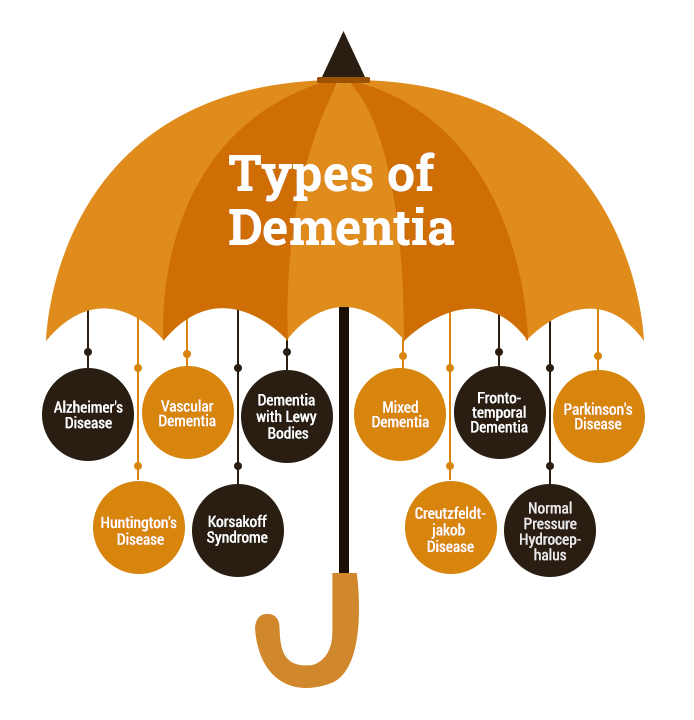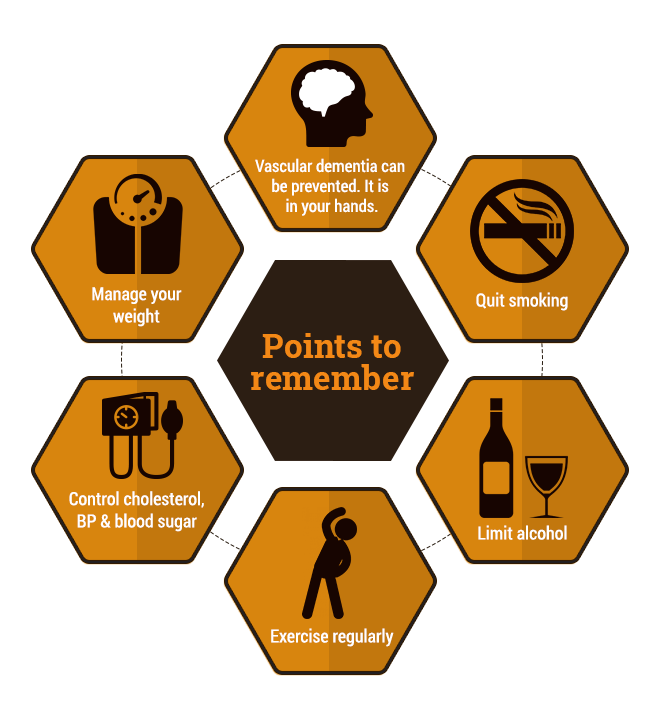Dementia is an umbrella term for a decline in memory and thinking ability severe enough to hinder daily activities. There are many different types of dementia.

Alzheimer’s disease
It is the most common type of dementia (60-80 % of cases of dementia are diagnosed to be Alzheimer’s)
Alzheimer’s is a progressive disease, where the symptoms gradually worsen over the years. More than 3.7 million Indians already have Alzheimer’s. The most unfortunate part of Alzheimer’s is that it is a progressive disease that worsens over time, and there is no cure yet. However, the treatment that can temporarily stall the worsening of Alzheimer’s symptoms and improve the quality of life of the sufferers is available.
Some points to be noted
Alzheimer’s is not normal ageing
Though some warning signals of Alzheimer’s may be similar to those normal in ageing, Alzheimer’s is much more devastating than normal age-related neurological decline.
Alzheimer’s can sometimes strike young
Though more common in people aged 65 or older, the warning signs of Alzheimer’s can sometimes be seen in people in their forties or fifties. This condition is known as early–onset Alzheimer’s disease.
Alzheimer’s may be in your genes
Genes are like your body’s instruction manual. So, having a slightly different gene can make you prone to some conditions. Researchers have proven that there may be a genetic cause behind Alzheimer’s; the genetic villain here has been identified as the APOE e4 gene, also called the apolipoprotein E.
However, it is important to note that not everyone with APOE e4 genes develops Alzheimer’s. The reverse is also true that Alzheimer’s often strikes those with no APOE e4 genes.
Vascular dementia
The brain has an intricate network of blood vessels. During a stroke, one or many of these blood vessels may be bleeding or blockage. If the blood supply is weaned off, that particular brain area may become deprived of oxygen and get damaged.
Cause
Each region of the brain is associated with a particular function. If the stroke occurs in the area responsible for memory and thinking ability, it may result in vascular dementia. Behavior and thinking changes may occur immediately during or after the stroke or become evident as the blood vessels get further damaged.
Symptoms
- Disorientation
- Lack of judgment
- Difficulty in speech and communication
- Vision loss

Dementia with Lewy bodies (DLB)
DLB is a type of memory decline caused by clusters or groups of a protein called alpha-synuclein.
Causes
Lewy bodies are clusters of proteins called alpha-synuclein. These accumulate in brain cells and damage them. If these occur in a particular part of the brain called the cortex, it can cause a deterioration in thinking ability, memory, and understanding skills.
Sometimes, Lewy bodies can be present simultaneously as Alzheimer’s or vascular dementia and contribute to the brain damage caused by this or can exist alone.
Symptoms

Points to remember
- In DLB, movement problems and dementia symptoms may present simultaneously or within one year of each other.
- DLB symptoms worsen over time and shorten lifespan.
Mixed dementia
In this type of memory decline, more than one type of dementia co-exists simultaneously in the brain. It is also referred to as “Multi-factorial dementia.”
Causes
Both brain blocks, like in vascular dementia, and amyloid plaques, like Alzheimer’s, or the occurrence of amyloid protein along with Lewy bodies or all three together can cause this type of dementia.
Symptoms
Depending upon which types of dementia are in combination, mixed dementia can have any or all of the following symptoms.

Points to remember
Diagnosis gets confusing due to more than one type of dementia.
Frontotemporal Dementia
This type of dementia is characterized by the loss of brain nerve cells in the areas behind the temples and the ear region
Causes
Frontotemporal dementia is mostly inherited. That means if someone in the family has it, you will likely get it. Deposition of different types of protein (tau and TDP43) in the brain causes this debilitating condition. FTD symptoms worsen as time passes.
Symptoms
- Difficulty in muscle coordination
- Muscle weakness
- Irritability and aggression
- A problem in controlling the bowels and the bladder
- Difficulty in chewing and swallowing
- Changes in eye movements
- Loss of ability to understand speech or express in a sentence
Points to remember
- No specific treatment.
- High risk of lung, skin, and urinary tract infections
- Progressive, likely to worsen over time.
Parkinson’s Disease
Parkinson’s disease is the second most common neurodegenerative disease (a disease in which the brain cells start malfunctioning). It is caused due to a decline in the brain messenger bio-molecule, “dopamine.”
Causes
Dopamine is an important chemical that acts as a cell messenger. It helps to give the signal to activate movement in a particular part of the body. In Parkinson’s disease, the cells in a specific brain region called the substantia nigra, responsible for the manufacture of dopamine, begin to die. When the dopamine levels start dropping, movements become uncontrolled, which is the main symptom of Parkinson’s disease.
- Scientists have found that people with Parkinson’s have clusters or clumps of protein(alpha-synuclein) called Lewy bodies in their brains.
Symptoms

Points to remember
The risk of developing Parkinson’s increases with risk factors like
- Age (65 or older)
- Exposure to pesticides and insecticides
- Family history of Parkinson’s
- Head trauma
Huntington’s disease
Huntington’s disease is a type of brain disorder that is caused due to damage to the cells in the central part of the brain.
Causes
A human being has 23 chromosomes. When one of these chromosomes, specifically chromosome 4, has a defective gene, the person has Huntington’s disease. This defective gene codes for an unwanted protein called Huntington, which triggers abnormal changes in the brain.
Symptoms
- Uncontrolled movements of limbs, head, face, and upper body
- Loss of thinking and reasoning
- Deterioration in thinking and planning skills
- Depression and anxiety
- Compulsive behavior like doing the same activity again and again.
- Irritation and aggressive behavior
Points to remember
A genetic test is available to detect the defective gene of Huntington’s disease.
No cure but treatment is given to managing the symptoms
Korsakoff syndrome
Korsakoff’s syndrome is a type of memory decline caused by a severe deficiency of vitamin thymine (Vitamin B1). Vitamins have many functions in the body. Vitamin B1, or thymine, is an essential vitamin.
Vitamin B1 has several important roles to play in normal body functioning. One of these roles is to help produce energy from glucose in the brain cells. When the levels of thiamine drop low, the brain cells start to be starved of energy.
Causes
Thiamine is an essential vitamin that makes a vital contribution to brain functioning. It helps the brain cells to garner energy from glucose. It is also needed to manufacture and function various neurotransmitters (molecules that allow brain cells to communicate and signal). The chronic lack of this important vitamin causes a decrease in the levels of various brain biomolecules leading to brain cell damage.
Symptoms
- Severe memory loss
- Inability to grasp new information
- Inability to recall recent events
Points to remember
Severe deficiency of thiamine may trigger a brain attack called Wernicke encephalopathy. It may happen just before the start of Korsakoff syndrome.
Korsakoff syndrome is a medical emergency that can cause lethal consequences. Some symptoms of this dangerous brain attack may be staggering and stumbling, lack of coordination, and abnormal involuntary eye movements.
Risk factors
- Excessive alcohol usage
- Medical conditions like AIDS
- Chronic infection
- Kidney issues like those on dialysis
- Thoughtless dieting and weight loss surgery
- Poor nutrition
Creutzfeldt-Jakob disease
Creutzfeldt-Jakob disease is a type of memory decline disease that worsens rapidly, unlike other types of dementia, such as Alzheimer’s or Frontotemporal dementia, which deteriorate gradually and slowly.
Causes
Creutzfeldt-Jakob disease occurs when a protein naturally found throughout the body, known as the prion protein, begins to get folded into an abnormal three-dimensional shape. This abnormal shapeshift in the brain cells damages them and leads to rapid deterioration of thinking and reasoning ability.
Symptoms
- Mood swings
- The rapid decline in thinking and reasoning skills
- Memory disruption
- Speedily increasing confusion and disorientation
- Rapidly weakening of memory
- Agitation
- Reclusive behavior or social withdrawal
- Muscle rigidity and jerky movements
- Difficulty in walking
Points to remember
The rapid progress of memory and thinking decline is the main sign to diagnose Creutzfeldt-Jakob disease.
Tests like EEG and MMR may confirm the diagnosis of Creutzfeldt-Jakob disease.
This disorder can be inherited; genetic testing can ensure if a family member has inherited this type of abnormal gene.
The rapid decline of abilities makes the sufferer highly dependent on the caregiver.
Risk factors
- Excessive alcohol usage
- Medical conditions like AIDS
- Chronic infection
- Kidney issues like those on dialysis
- Thoughtless dieting and weight loss surgery
- Poor nutrition
Normal pressure Hydrocephalus (NPH)
‘Hydro’ means water, and ‘cephalus’ means the brain. So this word means water in the brain. NPH is a disorder in which cerebrospinal fluid collects in the parts of the brain, causing a decline in thinking and planning abilities and a dip in memory. Read more
Causes
The cerebrospinal fluid is a colorless liquid that is found in the brain. Its role is to act as a cushion or a buffer and protect the brain from mechanical shocks and injury inside the skull. In NPH, excessive cerebrospinal fluid starts collecting in the brain’s chambers. Despite this excess liquid, the cerebrospinal fluid pressure remains normal if tested by doing a spinal tap.
Symptoms
- The decline in thinking and logical ability
- Change in gait and posture
- Mood, personality, and behavior changes
- Loss in bladder control
Points to remember
Sometimes, NPH may occur after brain events like hemorrhages.
Shunting (draining cerebrospinal fluid) from the brain may help in some cases.




